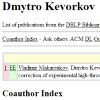| |
  
Matthieu Willems,
Nadia Tahiri and
Vladimir Makarenkov. A new efficient algorithm for inferring explicit hybridization networks following the Neighbor-Joining principle. In JBCB, Vol. 12(5), 2014.
Keywords: explicit network, from distances, heuristic, phylogenetic network, phylogeny, reconstruction.
Toggle abstract
"Several algorithms and software have been developed for inferring phylogenetic trees. However, there exist some biological phenomena such as hybridization, recombination, or horizontal gene transfer which cannot be represented by a tree topology. We need to use phylogenetic networks to adequately represent these important evolutionary mechanisms. In this article, we present a new efficient heuristic algorithm for inferring hybridization networks from evolutionary distance matrices between species. The famous Neighbor-Joining concept and the least-squares criterion are used for building networks. At each step of the algorithm, before joining two given nodes, we check if a hybridization event could be related to one of them or to both of them. The proposed algorithm finds the exact tree solution when the considered distance matrix is a tree metric (i.e. it is representable by a unique phylogenetic tree). It also provides very good hybrids recovery rates for large trees (with 32 and 64 leaves in our simulations) for both distance and sequence types of data. The results yielded by the new algorithm for real and simulated datasets are illustrated and discussed in detail. © Imperial College Press."
|
|
| |
  
Mehdi Layeghifard,
Pedro R. Peres-Neto and
Vladimir Makarenkov. Inferring explicit weighted consensus networks to represent alternative evolutionary histories. In BMCEB, Vol. 13(274):1-25, 2013.
Keywords: explicit network, from rooted trees, from species tree, phylogenetic network, phylogeny, Program ConsensusNetwork, reconstruction.
Note: http://dx.doi.org/10.1186/1471-2148-13-274.
Toggle abstract
"Background: The advent of molecular biology techniques and constant increase in availability of genetic material have triggered the development of many phylogenetic tree inference methods. However, several reticulate evolution processes, such as horizontal gene transfer and hybridization, have been shown to blur the species evolutionary history by causing discordance among phylogenies inferred from different genes. Methods. To tackle this problem, we hereby describe a new method for inferring and representing alternative (reticulate) evolutionary histories of species as an explicit weighted consensus network which can be constructed from a collection of gene trees with or without prior knowledge of the species phylogeny. Results: We provide a way of building a weighted phylogenetic network for each of the following reticulation mechanisms: diploid hybridization, intragenic recombination and complete or partial horizontal gene transfer. We successfully tested our method on some synthetic and real datasets to infer the above-mentioned evolutionary events which may have influenced the evolution of many species. Conclusions: Our weighted consensus network inference method allows one to infer, visualize and validate statistically major conflicting signals induced by the mechanisms of reticulate evolution. The results provided by the new method can be used to represent the inferred conflicting signals by means of explicit and easy-to-interpret phylogenetic networks. © 2013 Layeghifard et al.; licensee BioMed Central Ltd."
|
|
| |
  
Alix Boc,
Alpha B. Diallo and
Vladimir Makarenkov. T-REX: a web server for inferring, validating and visualizing phylogenetic trees and networks. In NAR, Vol. 40(W1):W573-W579, 2012.
Keywords: from rooted trees, from species tree, lateral gene transfer, phylogenetic network, phylogeny, Program T REX, reconstruction, reticulogram, software.
Note: http://dx.doi.org/10.1093/nar/gks485.
Toggle abstract
"T-REX (Tree and reticulogram REConstruction) is a web server dedicated to the reconstruction of phylogenetic trees, reticulation networks and to the inference of horizontal gene transfer (HGT) events. T-REX includes several popular bioinformatics applications such as MUSCLE, MAFFT, Neighbor Joining, NINJA, BioNJ, PhyML, RAxML, random phylogenetic tree generator and some well-known sequence-to-distance transformation models. It also comprises fast and effective methods for inferring phylogenetic trees from complete and incomplete distance matrices as well as for reconstructing reticulograms and HGT networks, including the detection and validation of complete and partial gene transfers, inference of consensus HGT scenarios and interactive HGT identification, developed by the authors. The included methods allows for validating and visualizing phylogenetic trees and networks which can be built from distance or sequence data. The web server is available at: www.trex.uqam.ca. © 2012 The Author(s)."
|
|
| |
 
Alix Boc and
Vladimir Makarenkov. Towards an accurate identification of mosaic genes and partial horizontal gene transfers. In NAR, Vol. 39(21):e144, 2011.
Keywords: explicit network, from sequences, lateral gene transfer, phylogenetic network, phylogeny, Program T REX, reconstruction.
Note: http://dx.doi.org/10.1093/nar/gkr735.
Toggle abstract
"Many bacteria and viruses adapt to varying environmental conditions through the acquisition of mosaic genes. A mosaic gene is composed of alternating sequence polymorphisms either belonging to the host original allele or derived from the integrated donor DNA. Often, the integrated sequence contains a selectable genetic marker (e.g. marker allowing for antibiotic resistance). An effective identification of mosaic genes and detection of corresponding partial horizontal gene transfers (HGTs) are among the most important challenges posed by evolutionary biology. We developed a method for detecting partial HGT events and related intragenic recombination giving rise to the formation of mosaic genes. A bootstrap procedure incorporated in our method is used to assess the support of each predicted partial gene transfer. The proposed method can be also applied to confirm or discard complete (i.e. traditional) horizontal gene transfers detected by any HGT inferring method. While working on a full-genome scale, the new method can be used to assess the level of mosaicism in the considered genomes as well as the rates of complete and partial HGT underlying their evolution. © 2011 The Author(s)."
|
|
| |
|
| |
   
Galina Glazko,
Vladimir Makarenkov,
Jing Liu and
Arcady Mushegian. Evolutionary history of bacteriophages with double-stranded DNA genomes. In Biology Direct, Vol. 2(36), 2007.
Keywords: explicit network, from sequences, phylogenetic network, phylogeny, Program T REX.
Note: http://dx.doi.org/10.1186/1745-6150-2-36.
Toggle abstract
"Background: Reconstruction of evolutionary history of bacteriophages is a difficult problem because of fast sequence drift and lack of omnipresent genes in phage genomes. Moreover, losses and recombinational exchanges of genes are so pervasive in phages that the plausibility of phylogenetic inference in phage kingdom has been questioned. Results: We compiled the profiles of presence and absence of 803 orthologous genes in 158 completely sequenced phages with double-stranded DNA genomes and used these gene content vectors to infer the evolutionary history of phages. There were 18 well-supported clades, mostly corresponding to accepted genera, but in some cases appearing to define new taxonomic groups. Conflicts between this phylogeny and trees constructed from sequence alignments of phage proteins were exploited to infer 294 specific acts of intergenome gene transfer. Conclusion: A notoriously reticulate evolutionary history of fast-evolving phages can be reconstructed in considerable detail by quantitative comparative genomics. © 2007 Glazko et al; licensee BioMed Central Ltd."
|
|
| |
|
| |
|
| |
|
| |
|
|
|
| |
  
Vladimir Makarenkov,
Alix Boc and
Pierre Legendre. A New Algorithm for Inferring Hybridization Events Based on the Detection of Horizontal Gene Transfers. In
Fuad Aleskerov,
Boris Goldengorin and
Panos M. Pardalos editors, Clusters, Orders, and Trees: Methods and Applications, Vol. 92 of Springer Optimization and Its Applications, Springer, 2014.
Keywords: explicit network, phylogenetic network, phylogeny, reconstruction.
|
|
| |
  
Vladimir Makarenkov,
Dmytro Kevorkov and
Pierre Legendre. Phylogenetic Network Construction Approaches. In Applied Mycology and Biotechnology, Vol. 6:61-97, 2006.
Keywords: from distances, hybridization, lateral gene transfer, median network, NeighborNet, netting, Program Arlequin, Program Network, Program Pyramids, Program Reticlad, Program SplitsTree, Program T REX, Program TCS, Program WeakHierarchies, pyramid, reticulogram, split, split decomposition, split network, survey, weak hierarchy.
Note: http://www.labunix.uqam.ca/~makarenv/makarenv/MKL_article.pdf.
|
|
|
|
 - forked on GitHub.
- forked on GitHub.















